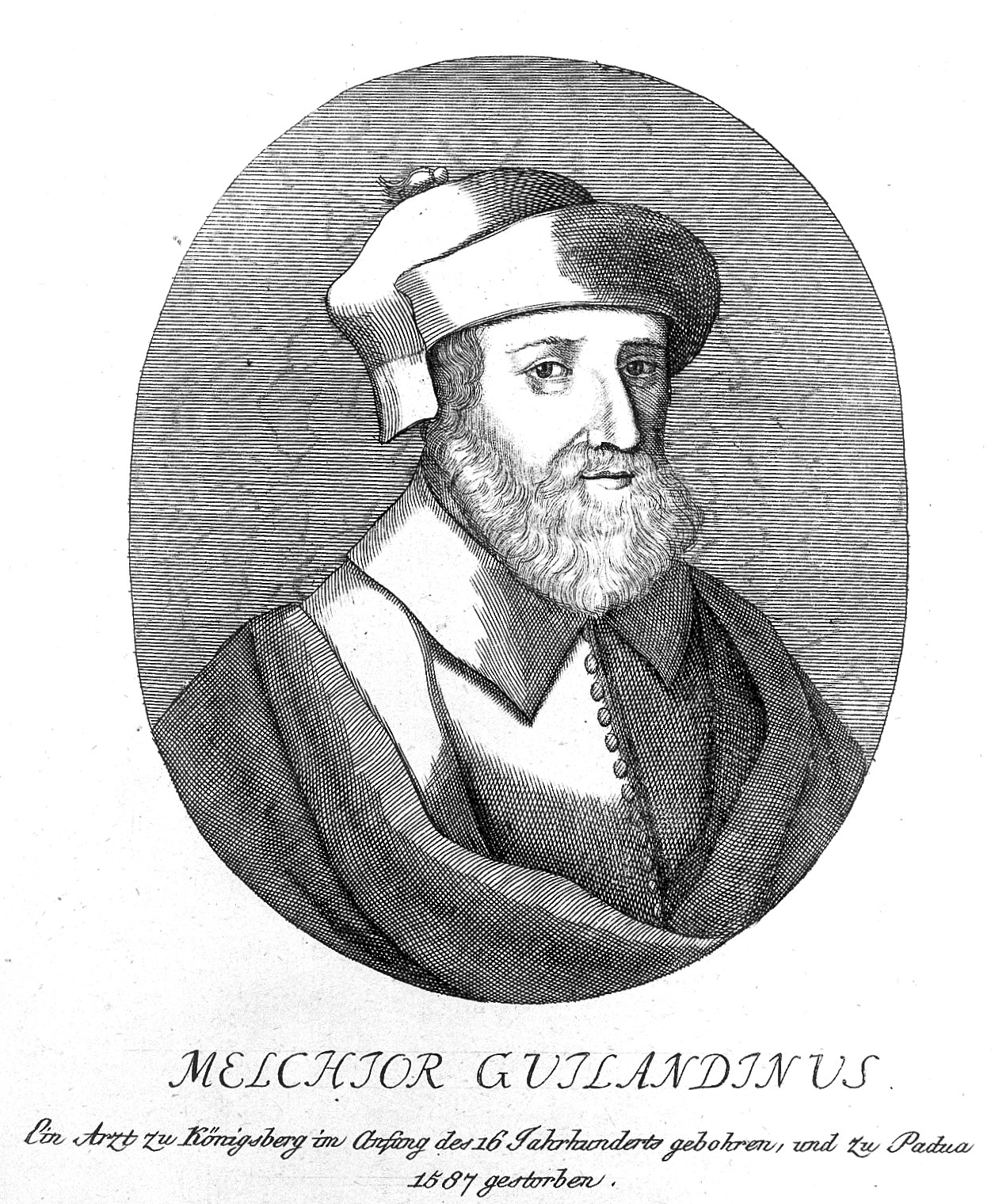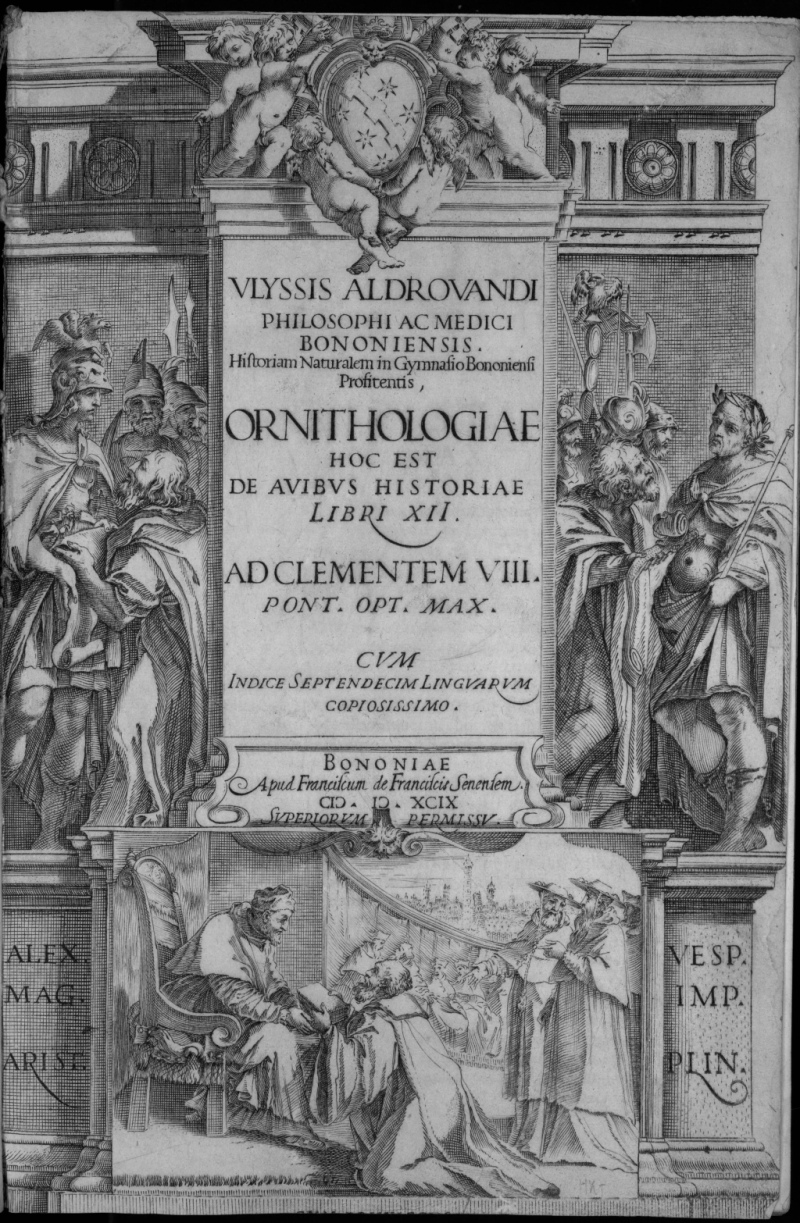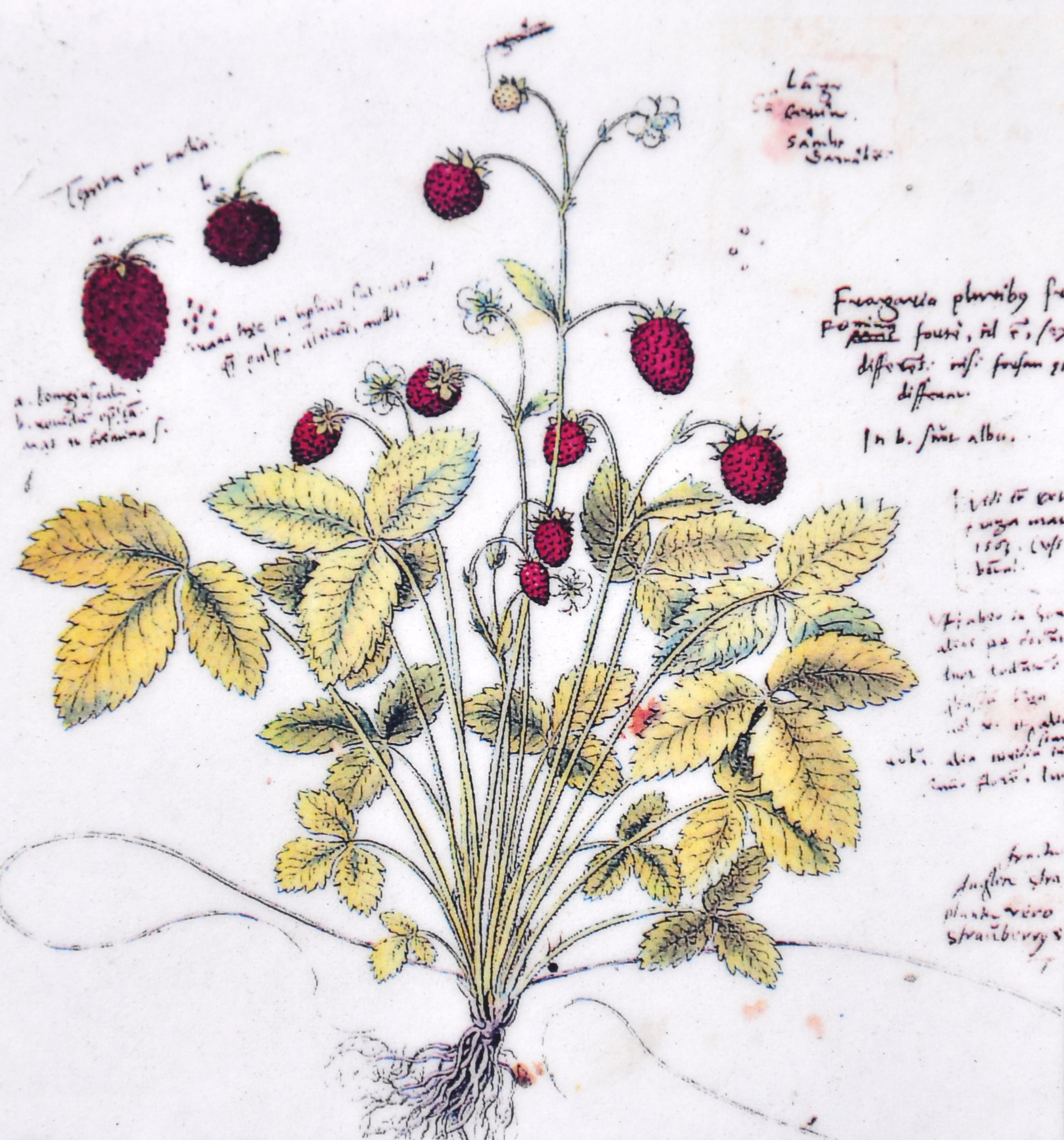|
Melchior Wieland
Melchior Wieland Latinized as Melchior Guilandinus with the Italian form Melchiorre Guilandino (c. 1520 – 25 December 1589) was a Prussian botanist and physician who worked in Padua. Wieland was born in Königsberg and was educated at the University of Königsberg after which he moved to Italy. He sold herbs and later travelled through Asia into Egypt with letters of introduction from Senator Marino Cavalli of Padua. His ship was captured by Algerian pirates at Cagliari and employed as a galley slave. He was returned to Genoa with his ransom paid by his friend Gabriele Falloppio and then moved to Venice. In 1561 he became director of the Padua botanical garden and taught pharmacognosy. He is known mostly from his letters to Falloppio, Ulisse Aldrovandi, and had a bitter feud with Pietro Andrea Mattioli. His detractor Mattioli seems to have been angered by communications between Wieland and Conrad Gessner. Mattioli claimed that Wieland was the illegitimate son of a priest and a p ... [...More Info...] [...Related Items...] OR: [Wikipedia] [Google] [Baidu] |
Melchior Guilandinus
Melchior Wieland Latinized as Melchior Guilandinus with the Italian form Melchiorre Guilandino (c. 1520 – 25 December 1589) was a Prussian botanist and physician who worked in Padua. Wieland was born in Königsberg and was educated at the University of Königsberg after which he moved to Italy. He sold herbs and later travelled through Asia into Egypt with letters of introduction from Senator Marino Cavalli of Padua. His ship was captured by Algerian pirates at Cagliari and employed as a galley slave. He was returned to Genoa with his ransom paid by his friend Gabriele Falloppio and then moved to Venice. In 1561 he became director of the Padua botanical garden and taught pharmacognosy. He is known mostly from his letters to Falloppio, Ulisse Aldrovandi, and had a bitter feud with Pietro Andrea Mattioli. His detractor Mattioli seems to have been angered by communications between Wieland and Conrad Gessner. Mattioli claimed that Wieland was the illegitimate son of a priest and a pr ... [...More Info...] [...Related Items...] OR: [Wikipedia] [Google] [Baidu] |
Königsberg
Königsberg (, ) was the historic Prussian city that is now Kaliningrad, Russia. Königsberg was founded in 1255 on the site of the ancient Old Prussian settlement ''Twangste'' by the Teutonic Knights during the Northern Crusades, and was named in honour of King Ottokar II of Bohemia. A Baltic port city, it successively became the capital of the Królewiec Voivodeship, the State of the Teutonic Order, the Duchy of Prussia and the provinces of East Prussia and Prussia. Königsberg remained the coronation city of the Prussian monarchy, though the capital was moved to Berlin in 1701. Between the thirteenth and the twentieth centuries, the inhabitants spoke predominantly German, but the multicultural city also had a profound influence upon the Lithuanian and Polish cultures. The city was a publishing center of Lutheran literature, including the first Polish translation of the New Testament, printed in the city in 1551, the first book in Lithuanian and the first Lutheran catechism, ... [...More Info...] [...Related Items...] OR: [Wikipedia] [Google] [Baidu] |
University Of Königsberg
The University of Königsberg (german: Albertus-Universität Königsberg) was the university of Königsberg in East Prussia. It was founded in 1544 as the world's second Protestant academy (after the University of Marburg) by Duke Albert of Prussia, and was commonly known as the Albertina. Following World War II, the city of Königsberg was transferred to the Soviet Union according to the 1945 Potsdam Agreement, and renamed Kaliningrad in 1946. The Albertina was closed and the remaining non-Lithuanian population either executed or expelled, by the terms of the Potsdam Agreement. Today, the Immanuel Kant Baltic Federal University in Kaliningrad claims to maintain the traditions of the Albertina. History Albert, former Grand Master of the Teutonic Knights and first Duke of Prussia since 1525, had purchased a piece of land behind Königsberg Cathedral on the Kneiphof island of the Pregel River from the Samland chapter, where he had an academic gymnasium (school) erected in 154 ... [...More Info...] [...Related Items...] OR: [Wikipedia] [Google] [Baidu] |
Cagliari
Cagliari (, also , , ; sc, Casteddu ; lat, Caralis) is an Italian municipality and the capital of the island of Sardinia, an autonomous region of Italy. Cagliari's Sardinian name ''Casteddu'' means ''castle''. It has about 155,000 inhabitants, while its metropolitan city (including Cagliari and 16 other nearby municipalities) has more than 431,000 inhabitants. According to Eurostat, the population of the Functional urban area, the commuting zone of Cagliari, rises to 476,975. Cagliari is the 26th largest city in Italy and the largest city on the island of Sardinia. An ancient city with a long history, Cagliari has seen the rule of several civilisations. Under the buildings of the modern city there is a continuous stratification attesting to human settlement over the course of some five thousand years, from the Neolithic to today. Historical sites include the prehistoric Domus de Janas, very damaged by cave activity, a large Carthaginian era necropolis, a Roman era amphith ... [...More Info...] [...Related Items...] OR: [Wikipedia] [Google] [Baidu] |
Gabriele Falloppio
Gabriele Falloppio (also Gabrielle Falloppia) (1522/23 – 9 October 1562) was an Italian anatomist often known by his Latin name Fallopius. He was one of the most important human anatomy, anatomists and physicians of the sixteenth century, giving his name to the Fallopian tube. Life Falloppio grew up in Modena. His father died early but thanks to the support of affluent relatives he enjoyed are thorough humanist education in Modena, learning Latin and Greek and moving in the local circle of humanist scholars. He was for some years in the service of the Church, among others as a kind of warden at Modena's cathedral, but soon turned to medicine. In 1544, he performed a public anatomy in Modena. In 1545, at the latest, he began to study medicine at the University of Ferrara, at that time one of the best medical schools in Europe. It was there also that he much later, in 1552, when he was already professor in Padua, received his medical doctorate under the guidance of Antonio Musa ... [...More Info...] [...Related Items...] OR: [Wikipedia] [Google] [Baidu] |
Ulisse Aldrovandi
Ulisse Aldrovandi (11 September 1522 – 4 May 1605) was an Italian naturalist, the moving force behind Bologna's botanical garden, one of the first in Europe. Carl Linnaeus and the comte de Buffon reckoned him the father of natural history studies. He is usually referred to, especially in older scientific literature in Latin, as Aldrovandus; his name in Italian is equally given as Aldroandi. Life Aldrovandi was born in Bologna to Teseo Aldrovandi and his wife, a noble but poor family. His father was a lawyer, and Secretary to the Senate of Bologna, but died when Ulisse was seven years old. His widowed mother wanted him to become a jurist. Initially he was sent to apprentice with merchants as a scribe for a short time when he was 14 years old, but after studying mathematics, Latin, law, and philosophy, initially at the University of Bologna, and then at the University of Padua in 1545, he became a notary. His interests successively extended to philosophy and logic, which he c ... [...More Info...] [...Related Items...] OR: [Wikipedia] [Google] [Baidu] |
Pietro Andrea Mattioli
Pietro Andrea Gregorio Mattioli (; 12 March 1501 – ) was a doctor and naturalist born in Siena. Biography He received his MD at the University of Padua in 1523, and subsequently practiced the profession in Siena, Rome, Trento and Gorizia, becoming personal physician of Ferdinand II, Archduke of Further Austria in Prague and Ambras Castle, and of Maximilian II, Holy Roman Emperor in Vienna. Mattioli described the first case of cat allergy. His patient was so sensitive to cats that if he was sent into a room with a cat he reacted with agitation, sweating and pallor. A careful student of botany, he described 100 new plants and coordinated the medical botany of his time in his ''Discorsi'' ("Commentaries") on the ''De Materia Medica'' of Dioscorides. The first edition of Mattioli's work, the Italian translation of ''De Materia Medica'', supplemented with his own commentaries, appeared in 1544 in Venice. There were several later editions in Italian. In 1554 the first edition ... [...More Info...] [...Related Items...] OR: [Wikipedia] [Google] [Baidu] |
Conrad Gessner
Conrad Gessner (; la, Conradus Gesnerus 26 March 1516 – 13 December 1565) was a Swiss physician, naturalist, bibliographer, and philologist. Born into a poor family in Zürich, Switzerland, his father and teachers quickly realised his talents and supported him through university, where he studied classical languages, theology and medicine. He became Zürich's city physician, but was able to spend much of his time on collecting, research and writing. Gessner compiled monumental works on bibliography (''Bibliotheca universalis'' 1545–1549) and zoology (''Historia animalium'' 1551–1558) and was working on a major botanical text at the time of his death from plague at the age of 49. He is regarded as the father of modern scientific bibliography, zoology and botany. He was frequently the first to describe species of plants or animals in Europe, such as the tulip in 1559. A number of plants and animals have been named after him. Life Conrad Gessner was born on 26 March 1516, ... [...More Info...] [...Related Items...] OR: [Wikipedia] [Google] [Baidu] |
Guilandina
''Guilandina'' is a genus of flowering plants in the legume family, Fabaceae. It belongs to the subfamily Caesalpinioideae and tribe Caesalpinieae. The genus was named after Melchior Wieland (1515–1589), a Prussian naturalist who "Italianized" his name as "Guilandini" upon moving to Italy. Species The genus ''Guilandina'' comprises the following species: * '' Guilandina barkeriana'' (Urb. & Ekman) Britton (Cuba, Haiti) * '' Guilandina bonduc'' L. 1753 – grey nicker, knicker nut (pantropical) * '' Guilandina caymanensis'' (Millsp.) Britton & Rose (Cayman Islands) * '' Guilandina ciliata'' Bergius ex Wikstrom – broadpad nicker (Caribbean) * '' Guilandina culebrae'' Britton & Wilson ex Britton & Rose – smooth yellow nicker (Puerto Rico) * '' Guilandina glaucophylla'' (Urb.) Britton & Rose (Cuba, Swan Islands) * '' Guilandina intermedia'' (Urb.) Britton & Rose (Cuba, Jamaica) * '' Guilandina major'' (DC.) Small – yellow nicker (pantropical) * '' Guilandina portoricensis'' B ... [...More Info...] [...Related Items...] OR: [Wikipedia] [Google] [Baidu] |
Prospero Alpini
Prospero Alpini (also known as Prosper Alpinus, Prospero Alpinio and Latinized as Prosperus Alpinus) (23 November 15536 February 1617) was a Venetian physician and botanist. He travelled around Egypt and served as the fourth prefect in charge of the botanical garden of Padua. He wrote several botanical treatises which covered exotic plants of economic and medicinal value. His description of coffee and banana plants are considered the oldest in European literature. The ginger-family genus ''Alpinia'' was named in his honour by Carolus Linnaeus. Biography Born at Marostica, a town near Vicenza, the son of Francesco, a physician, Alpini served in his youth for a time in the Milanese army, but in 1574 he went to study medicine at Padua. After taking his doctor's degree in 1578, he settled as a physician in Campo San Pietro, a small town in the Paduan territory. But his tastes were botanical and influenced by Melchiorre Guilandino, and to extend his knowledge of exotic plants he t ... [...More Info...] [...Related Items...] OR: [Wikipedia] [Google] [Baidu] |
1589 Deaths
Events January–June * War of the Three Henrys: In France, the Catholic League is in rebellion against King Henry III, in revenge for his murder of Henry I, Duke of Guise in December 1588. The King makes peace with his old rival, the Huguenot Henry of Navarre, his designated successor, and together they besiege Paris. * January 26 – Job is elected as the first Patriarch of Moscow and All Russia. * February 26 – Valkendorfs Kollegium is founded in Copenhagen, Denmark. * April 13 – An English Armada, led by Sir Francis Drake and Sir John Norreys, and largely financed by private investors, sets sail to attack the Iberian Peninsula's Atlantic coast, but fails to achieve any naval advantage. July–December * August 1 – King Henry III of France is stabbed by the fanatical Dominican friar Jacques Clément (who is immediately killed). * August 2 – Following the death of Henry III of France, his army is thrown into confusion and an ... [...More Info...] [...Related Items...] OR: [Wikipedia] [Google] [Baidu] |
Herbalists
Herbal medicine (also herbalism) is the study of pharmacognosy and the use of medicinal plants, which are a basis of traditional medicine. With worldwide research into pharmacology, some herbal medicines have been translated into modern remedies, such as the anti-malarial group of drugs called artemisinin isolated from '' Artemisia annua'', a herb that was known in Chinese medicine to treat fever. There is limited scientific evidence for the safety and efficacy of plants used in 21st century herbalism, which generally does not provide standards for purity or dosage. The scope of herbal medicine commonly includes fungal and bee products, as well as minerals, shells and certain animal parts. Herbal medicine is also called phytomedicine or phytotherapy. Paraherbalism describes alternative and pseudoscientific practices of using unrefined plant or animal extracts as unproven medicines or health-promoting agents. Paraherbalism relies on the belief that preserving various s ... [...More Info...] [...Related Items...] OR: [Wikipedia] [Google] [Baidu] |

.jpg)






.jpg)